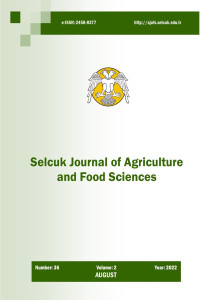The Incidence of Barley (Hordeum vulgare L.) Leaf Diseases in Central Anatolia Region of Turkey in 2020
Abstract
Barley (Hordeum vulgare L.) is one of the most important cereal crops that their grains are used in the malt and forage industry. Yield and quality losses occur in barley due to abiotic and biotic stress factors. Barley leaf diseases caused by fungal pathogens are common diseases leading to significant yield losses. Within the framework of environmentally-friendly integrated crop management,
disease-resistant varieties should be developed together with a breeding program for sustainable agriculture. In disease resistance studies, the first and the most important step is to monitor the situation of the disease agent(s) in a region or country. For this purpose; In 2019-2020, barley leaf diseases survey in 54 barley fields was done in 5 provinces of Central Anatolia (Ankara, Eskişehir, Kırıkkale, Kırşehir, Yozgat). As a result of the surveys, the most common disease was determined as barley stripe disease (Drechslera graminea). Barley net spot disease (D. teres f. maculata, D. teres f. teres), Barley leaf spot (Rhynchosporium commune) and Barley powdery mildew (E. graminis f. sp. hordei) diseases followed in this order.
Details
| Primary Language | English |
|---|---|
| Subjects | Botany |
| Journal Section | Research Article |
| Authors | |
| Publication Date | December 25, 2022 |
| Submission Date | February 10, 2022 |
| Published in Issue | Year 2022 Volume: 36 Issue: 3 |
Cite
Selcuk Agricultural and Food Sciences is licensed under a Creative Commons Attribution-NonCommercial 4.0 International License (CC BY NC).

